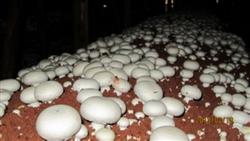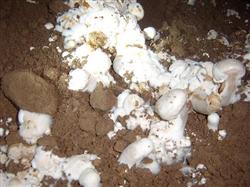Management of Pleurotus ostreatus emergence in Autumn

Pleurotus ostreatus belongs to medium and low temperature type mushrooms. The protein content of fresh mushrooms is 35%-38%, and its nutritional value is 412 times that of vegetables and fruits. It enjoys the laudatory names of "health food" and "king of vegetarian", and is favored by domestic and foreign markets. Pleurotus ostreatus is planted in Beijing, and the mushroom emergence period is from September to November and from April to May of the following year. The management of mushroom production of Pleurotus ostreatus can be divided into three different periods: autumn mushroom, overwintering mushroom and spring mushroom, of which autumn mushroom accounts for more than 70% of the total production, which should be the focus of management. At present, it is the key to the management of mushroom production in autumn, so we should focus on the following aspects in production: 1. Water management: the key is to control water consumption. Proper water use, exuberant mycelium growth, more fruiting bodies, and increased tide of mushroom production. Use too much water, will cause mycelium atrophy, mushroom fruiting body appear "rust spot", "red root" and so on. If the water is insufficient, the fruiting body is not full or there are scales on the surface. In general, when the early autumn mushroom grows to the size of soybeans, it is sprayed with heavy water to supply the water needed for the next wave of mushrooms. Do not spray water immediately before and after mushroom picking, so as not to affect the body quality of mushrooms and the formation of the next tide of mushrooms. In the later stage of autumn mushroom, the temperature drops, the amount of mushroom production decreases, and the amount of spraying water should be reduced, which is generally about 0.5 kg / square meter. Water spraying is best carried out at night or in the morning and evening. 2. Temperature management: during the mushroom emergence period, the temperature of the mushroom shed should be kept at 18 ℃-20 ℃. At lower temperature, the mushroom fruiting body is thick, it is not easy to open the umbrella, and the quality is good. In the early stage of autumn mushroom, when the greenhouse temperature is higher than 18 ℃, measures such as night ventilation, spraying water around the shed and thickening the sunshade layer can be taken to reduce the greenhouse temperature. In the later stage of autumn mushroom, when the greenhouse temperature is below 12 ℃, some measures can be taken to increase the greenhouse temperature, such as ventilation at noon, thickening grass carp at night, using black-and-white double film and so on. 3. Ventilation management: respiration is more exuberant in the growth and development stage of the fruiting body of Pleurotus ostreatus, with more carbon dioxide and high oxygen consumption, so ventilation must be done in the mushroom room after mushroom production. Especially in early autumn, high temperature and poor ventilation will lead to fruiting body dysplasia. Straw curtains are hung on the doors and windows of the mushroom shed, and water is sprayed on the straw curtains, so that the humidity in the shed can be maintained while ventilation is carried out, and hot air can be prevented from blowing directly onto the mushroom bed. Autumn mushroom later temperature is lower, less mushroom, can reduce ventilation, mainly to heat preservation, to prevent umbrella opening. Ventilation of mushroom rooms should be carried out at night or on rainy days. 4. Postharvest management: after each mushroom harvest, tweezers should be used to remove the dried, yellowed old roots and dead mushrooms on the bed in time to prevent mildew from causing diseases and insect pests. After each root picking, fill the soil in time to avoid stagnant water in the small hole after spraying water and affect the growth of mycelium. After a period of mushroom emergence, the nutrients continue to be consumed and the mushroom shape becomes smaller, so it must be combined with spraying 2% lime water and topdressing fertilizer. There are three kinds of commonly used topdressing: ① 2-5% industrial crude glucose or granulated sugar; ② 0.02% yeast powder; ③ 0.5% urea, potassium dihydrogen phosphate and so on.
- Prev

New management technology of cultivating Pleurotus ostreatus with corncob
1. The hyphae on the bed surface should appear at the right time, indicating that the hyphae have been sent to the bottom of the culture material and have been fully developed in the soil layer, and have the ability to bear mushrooms, so the bacterial water should be sprayed at the right time. Methods: increase ventilation, make the strong wind blow into the mushroom shed, make the soil surface mycelium lodge; according to the soil layer bacteria situation to master the amount of spraying water, generally per.
- Next

High-yielding cultivation techniques of two Tides of Pleurotus ostreatus
Brown rot, also known as white rot, wet bubble disease, blister disease, etc., diseased mushrooms are soaked when young, the disease is caused by a pathogen called verrucosporium. In the later stage, it forms irregular gray-white "pimple head" or deformed mushroom, and gives birth to a layer of "white hair" on the surface. That is, when the temperature of the pathogenic mycelium is above 20 ℃, it takes only 4-5 days.
Related
- Fuxing push coffee new agricultural production and marketing class: lack of small-scale processing plants
- Jujube rice field leisure farm deep ploughing Yilan for five years to create a space for organic food and play
- Nongyu Farm-A trial of organic papaya for brave women with advanced technology
- Four points for attention in the prevention and control of diseases and insect pests of edible fungi
- How to add nutrient solution to Edible Fungi
- Is there any good way to control edible fungus mites?
- Open Inoculation Technology of Edible Fungi
- Is there any clever way to use fertilizer for edible fungus in winter?
- What agents are used to kill the pathogens of edible fungi in the mushroom shed?
- Rapid drying of Edible Fungi

